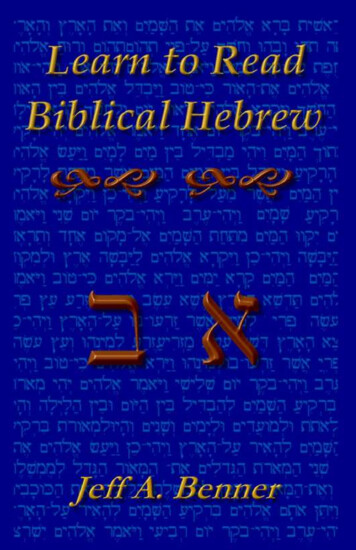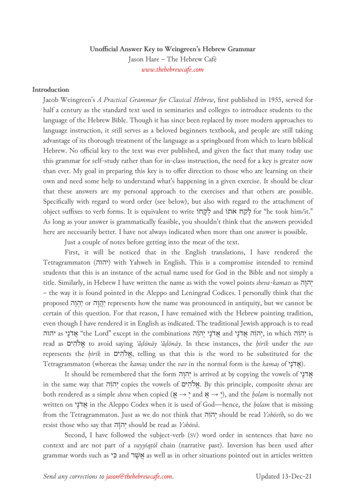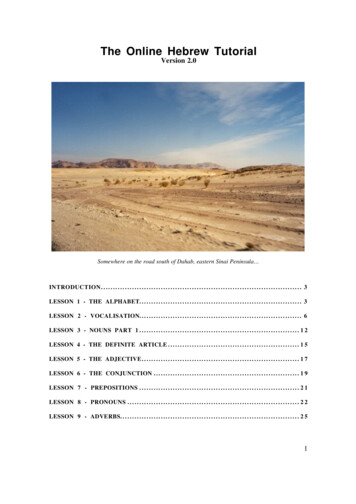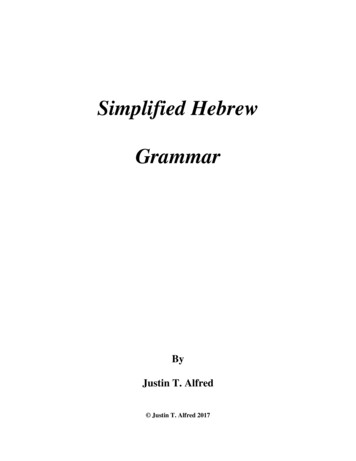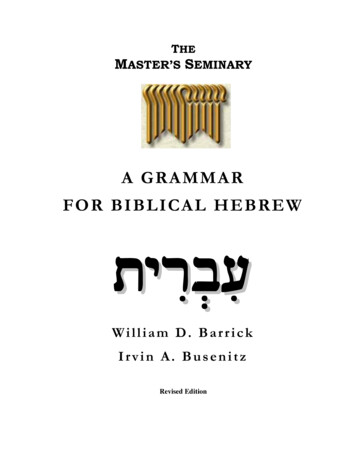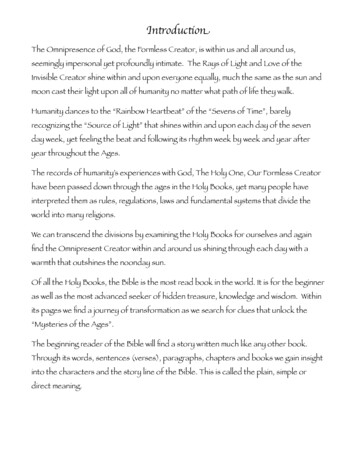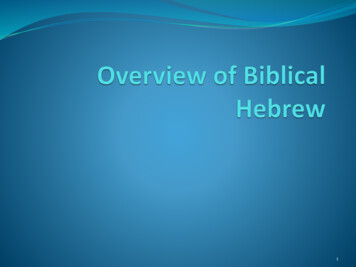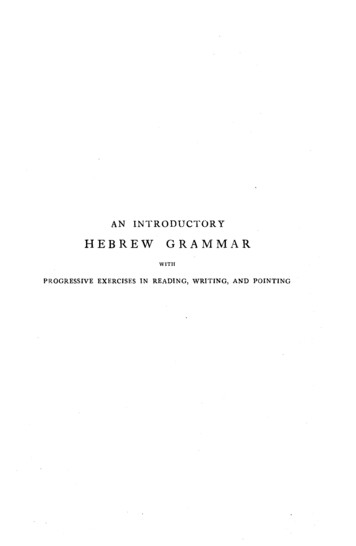
Transcription
AN INTRODUCTORYHEBREWGRAMMARWITHPROGRESSIVE EXERCISES IN READING, WRITING, AND POINTING
----- - - - - - - - - - - - - - - - - - - - - - - - - - ,In demy 8voHEBREW SYNTAXBY THE LATEA. B. DAVIDSON, L1TT.D., LL.D.PROFESSOR OF HEBREW AND OLD TESTAMENT EXEGESISNEW C0Ll.EGE 1 EDINBURGHTHIRD EDITION.10s.NET"A companion volume to the author's 'lntroductory HebrewGrammar/ the excellence of which may be inferred from thenumber of editions through which it has passed. . . . This'Syntax' is, undoubtedly, the best of its size hitherto producedin this country, and is in every way well adapted for students andfor practical teaching."-London Quarterly Review.EDINBURGH:T. & T. CLARK, 38GEORGE STREET
AN INTRODUCTORYHEBREW GRAMMARWITHPROGRESSIVE EXERCISES IN READINGWRITING, AND POINTINGBY THE LATEA. B. DAVIDSON, L1TT.D., LL.D.PROFESSOR OF HEBREW, ETC., IN THE NEW COLLEGE, EDINBURGHREVISED THROUGHOUT BYJOHN EDGAR McFADYEN, B.A.(OxoN.), M.A., D.D.PROFESSOR OF OLD TESTAMENT LANGUAGE, LITERATURE, AND THEOLOGYTRINITY COLLEGE, GLASGOWAUTHOR OPu 'IHE MESSAGE OF ISRAEL11(THE CHALMERS LECTURES)" INTRODUCTION TO THE OLD TESTAMENT u ETC.(TWENTY-FOURTH EDITION)EDINBURGH:T. & T. CLARK, 38GEORGE STREET
PRlNTJtD IN GREAT BRITAIN BYMORRISONANDGIBBLIMITEDFOR1& CLAR EDINBURGHLONDON: SIMPKIN MARSHALL, LIMITEDNEW YORK: CHARLES SCRJBNER 's SON8FIRST EDJTION ( nlirely re-set, anti r,vised throughout)(reP,intetl)(revised througlwul)TWENTY-SECOND EDITION (revised. tllrouglloul)(,.p,.,,te,J,)Tw&NTIEIH EDITION"TWENTY-FIRST EDITION(,eprin14a)TwKNTY THIRD EotTIONTWENTY·POURTH EDITION
PREFACE TO THE NINETEENTHEDITION.-- -AT the request of the publishers I have undertaken therevision of the late Professor A. B. Davidson's HebrewGrammar. With some reluctance, I confess; for it isalways dangerous to touch the work of another man,especially when that other is a master, and his work,in its original form, has achieved an almost uniquepopularity, as attested by eighteen successive editions.But two considerations decided me to make the attempt.Firstly, eighteen years of experience in teaching thegrammar and dealing with students in their initial struggleswith the language, have convinced me that there were nota few perplexities which did not readily resolve themselvesto men who had only an average stock of patience andlinguistic interest. And secondly, the publishers gave mean absolutely free hand. Of the liberty thus generouslyaccorded, I have made very ample use. With the exceptionof the vocabularies (which, however, have been slightlyextended by the addition of proper names) and of theexercises for translation (which again have been in placesconsiderably modified) little remains of the originalGrammar but the order of the sections.The following are some of the features of that Grammar. which seemed to call for special attention in a revi5ion.(i.) The very important sections I-:IO, on a complete undervii
viiiPREFACE TO THE NINETEENTH EDITION.standing of which practically everything depends, weresomewhat abstract in their complexion; and their usefulness, it seemed to me, might be considerably enhanced byfuller explanations and a more liberal use of illustration.(ii.) The sections in small print created a problem for thebeginner. He began by assuming that their contentscould be safely ignored at first, and usually ended byignoring them altogether. But these sections sometimescontained matter of first-rate importance. I have endeavoured to reduce the small print to a minimum,weaving the more important matter into the regularsections, and omitting whatever it did not seem strictlynecessary for the beginner to know, though there is roomfor legitimate difference of opinion as to where this lineought to be drawn.1 (iii.) The many references to OldTestament passages, which not one student in a hundredever looked up, I have omitted, giving instead one illustration (or more) which I have quoted in full. A vividillustration of an important principle strengthens thelearner's appreciation and grasp of the principle; and, forthis reason 1 I have throughout the book made comparatively lavish use of illustration, and-in the earlier sections-also of transliteration, in order that the beginner mightbe in no doubt as to the pronunciation of Hebrew words.(iv.) Frequently ditto marks were used to indicate, notthat the word above was to be repeated, but that theanalogy of the preceding column was to be followed ; insuch cases I have written the word in full. In other casesagain (e.g. § 29) the paradigms were too brief and left thestudent in the lurch just at the point where he mostneeded guidance. Doubtless perfect familiarity with earlier1 Throughout the translation exercises, e.g., I have indicated theMethegh; also the accents t'lluq and 'Athna/J, where the vowels wereaffected.
PREFACE TO THE NINETEENTH EDITION.ixanalogies would have enabled him to fill in the gaps, butthe average student could not do so with any confidence.In such cases I have written the paradigm in full, leaving nothing to guess-work or possible misconstruction.(v.) The vocabularies preceding the exercises were notseldom incomplete. No doubt the necessary words couldalways be found in the longer lists at the end of the book;but the fact that some words were given raised the verynatural presumption that all would be given, and thestudent, when he came to the translation, was oftendisappointed to find himself confronted with ords towhich his previous preparation, however careful, gave himno clue. I have therefore considerably extended thevocabularies to the sections, so as to include all thewords necessary for translation. (vi.) Some sections (e.g.on perfect and imperfect § 46, numerals § 48) containedno exercises-neither Hebrew into English, nor Englishinto Hebrew ; others contained only one or the other.To every section where these were wanting I have addedtranslation exercises of both types, on the principle thatone cannot see too much of a language one is trying tolearn. (vii.) I have added to each translation exercise,beginning with the very first, two or three sentences ofunpointed Hebrew for pointing as well as translation. Asan exercise, pointing is almost as useful as translating fromEnglish into Hebrew, and it has a fascination all its own.In every discussion and explanation I have endeavouredto place myself at the beginner's standpoint. and, so far aspossible, to offer a treatment which would be sufficient forhim without extraneous help. There is doubtless an inevitable amount of drudgery in the study of any language ;but the fundamental principles of Hebrew are really so fewand so pervasive that, if they are properly understood, thestrain upon the memory (except for vocabulary) is very
XPREFACE TO THE NINETEENTH EDITION.little. The all but universal repugnance to the study ofthe language is explained partly by the fact that it is begunlater in life than other languages, at a time when men'sminds are less responsive to, and more intolerant of, a newand unfamiliar discipline; but it is due also in part to themistaken idea that its principles are intricate and haphazard.Nothing could be further from the truth, and I have soughtto leave upon the reader's mind the conviction of theessential simplicity and regularity of the language.Despite the many modifications which I have introduced,I have worked with a full sense of the respect and gratitudedue to the noble scholar whose vital interpretation of theOld Testament so charmed and stimulated the successivegenerations of students and preachers who fell under itsspell ; and I could not wish for the grammar, in its newform, any better fortune than that it should win as manyfriends and exercise as wide an influence as it has done inthe past.I desire to acknowledge my special obligations toProfessor Arthur Ungnad's Hebriiische Grammatik, whichseems to me the most attractive treatment the subjecthas received in our generation.JOHN E. MCFADYEN.UNITED FREE CHURCH COLLEGE,GLASGOW,23rd Septembe1' 1914.
PREF ACE TO THE TWENTIETHEDITION.- -IN a little more than a year, another edition of theGrammar has been called for. This fact, coupled withassurances I have received from many parts of the world,-from professional scholars and teachers on the one hand,and from students on the other-encourages me in thehope that the revision was not undertaken in vain.This edition is not a mere reprint of the last. Thebook has been entirely reset. I have numbered practicallyevery paragraph in this new edition throughout, so that itought to be more convenient for purposes of reference.I have also incorporated suggestions submitted to meby various scholars, more particularly by the following,whom I desire herewith to thank-Rev. Canon Fowler,D.C.L., Hebrew Lecturer in the University of Durham;Rev. Prof. A. C. Welch, Th.D., of New College, Edinburgh;Rev. Prof. J. A. Selbie, D.D., of U.F. Church College,Aberdeen; and the Rev. Prof. J. Strahan, D.D., of MageeCollege, Londonderry.JOHN E. McFADYEN.UNITED FREE CHURCH COLLEGE,GLASGOW,IS! July 1916.xi
PREFACE TO THE TWENTY-FIRSTEDITION.THE urgent demand for a new edition of the Grammar isa welcome reminder that the upheaval caused by the GreatWar has not so seriously affected the study of ancientlanguages as some had feared. This is as it should be.The present is rooted in the past, and the accurate knowledge of a great literature is impossible without someacquaintance with the language in which it was written.I have taken the opportunity of removing a few slighttypographical blemishes, and of incorporating, where possible, suggestions made by various scholars, in particularby Geoffrey N. Bacon, Fellow and Tutor of St. Chad'sCollege, Durham.JOHN E. MCFADYEN.UNITED FREE CHURCH COLLEGE,GLASGOW,I1tk November1921.PREFACE TO THE TWENTY-FOURTHEDITION.demand for a new edition of the Grammar has furnishedme with the opportunity of improving it at many points.THEJOHN E. McFADYEN.TRINITY COLLEGE,GLASGOW,.2nd December1932.xii
CONTENTS.PAG IntroductionSECTION1.2.Hebrew AlphabetV owe! Sounds. Vowel Letters473. External Vowel Signs, Massoretic Points4. Coalition of Massoretic and Textual Vocalization135. Principles of the Syllable6. The Vowel System and the Tone7. Daghesh. The Letters B'ghadhk'phath211924308. The Gutturals .9. The Quiescents10. The Accents. Methegh. Maqqeph. Pause. Q re. K thibh343738The ArticlePersonal Pronouns13. Demonstrative, Relative, Interrogative, and other Pronouns14. Inseparable 12.20.The ConjunctionThe Noun. InflectionCases. Construct stateFirst DeclensionPronominal SuffixesThe Verb. PerfectThe Imperfect, &c.22. Verb Active and Stative (Transitive and Intransitive)23. Jussive, Cohortative, Waw consecutive24. Scheme of the Regular Verb .76So25. Niph'al8921.xiii8288
xivCONTENTS.PAGBSECTION26.27.28.29.30.Pi'el, Pu'al, Hithpa'elHiph'il, Hoph'alSkeleton Paradigm of Regular Verb.Second DeclensionThird 4.45.Verbal SuffixesIrregular or Weak Verbs106Pe Nun Verbs and NounsPe Guttural Verbs and Nounsn391959799104II2II5n8Pe 'Aleph Verbs'Ayin Guttural Verbs and NounsLamedh Guttural Verbs and Nouns'.Lamedh 'Aleph Verbs and Nouns120122Pe Yodh and Pe Waw Verbs'Ayin Waw and 'Ayin Yodh VerbsNouns 'Ayin Waw and 'Ayin Yodh131Double 'Ayin VerbsNouns Double 'Ayin .Lamedh He VerbsApocopated Forms and Nouns Lamedh HeDoubly Weak and Defective VerbsTable of Irregular Nouns .1241271341371401431461511 5346. Perfect, Imperfect, and Participle47. The Adjective, Comparison15548. The Numerals16316717149. ParticlesEnglish-Hebrew Vocabulary .Hebrew-English Vocabulary.Paradigms of VerbsThe Accents Index of SubjectsIndex of Hebrew Words1611892072302322 35
INTRODUCTION.
INTRODUCTION.THE beginner should enter upon his study of Hebrew withthe assurance that it is not only not more difficult, butin some important respects easier, to acquire a workingknowledge of that language than of most others. With areasonable amount of intelligent application, he will morequickly learn to read a piece of ordinary historical narrativein Hebrew than in Latin, Greek, or German.Hebrew, of course, has difficulties of its own, which mustbe frankly faced. Of these the three which meet the beginner on the threshold are (i.) the strangeness of thealphabet, (ii.) the fact that the language is read from rightto left, and (iii.) the unlikeness of some of the sounds toany in our own language. A little practice reduces thefirst two difficulties to the vanishing point: the third is moreserious. There are, e.g., two k sounds and two t sounds,one in either group having no equivalent in English. Thusif, for the one k which appears in kol, the word for all, wesubstitute the other k, we get the word for voice. Unless,therefore, we learn from the beginning to make some distinction between these sounds-and this is not easy-inpronunciation, we shall be in perpetual danger of confusingtotally dissimilar words. (iv.) Another difficulty is that theroots are almost entirely triliteral,1 with the result that, atfirst, the verbs at any rate all look painfully alike-e.g.malak, zakar, lamad, harag, &c.,-thus imposing upon the1 :1'1j:ll,I 'qrb may be a genuine quadriliteral ; but behind mostquadriliterals (cf. o,:, krml, garden-land) lies a triliteral root (e.g. c,:,krm, vineyard). There are probably also biliteral roots (§§ 40, 42).I
INTRODUCTION,2memory a seemingly intolerable strain. Compound verbsare impossible : there is nothing in Hebrew to correspond tothe great and agreeable variety presented by Latin, Greek,or German in such verbs as exire, inire, abire, redire, &c. ;,r.,1 r.,1,r.,1r.,1&c. ; ausge1zen,le", n, aufgehen, untergehen, &c. Every verb has to belearned separately: the verbs to go out, to go up, to go down,are all dissyllables of the type illustrated above, havingnothing in common with each other or with the verb to go.But against these difficulties have to be set facts whichweigh more heavily on the other side. (i.) The workingvocabulary of Hebrew is comparatively small. Many rarewords occur, as we should expect, in books like Job; butthe running vocabulary of average prose is meagre andsimple. To know a dozen or even half a dozen chaptersthoroughly is to have the key to an immensely wider area.(ii.) The noun has no case-endings, and the verb has onlytwo tenses. What a contrast with the elaborations of Latinand Greek, especially, e.g., of the Greek verb! (iii.) Hebrewsyntax, though it has many subtleties of its own, is, broadlyspeaking, extremely simple, as a glance at any literaltranslation of the Old Testament, with its ever recurringand, will show. The clauses in a Greek or Latin sentenceare built together : in Hebrew they are laid together. Bythe use of particles, participles, relative and other subordinate clauses, a number of thoughts are expressed inthose languages in their perspective and relation to eachother and presented as an artistic whole-it may be withonly one principal verb. The Hebrew habit is to coordinate rather than to subordinate, and one principal verbfollows another with a regularity which reminds one of thesimple speech of children. A piece of idiomatic Greek,such as the introductory words of Luke's Gospel, does notreadily go into Hebrew.Even simpler Greek wouldbecome simpler still in Hebrew. Take, e.g., Mat. 27. 28-30:"a '"Svuav-re,;; av-rov x"'ll.aµv'Sa KOKKlV'f/JJ 7repie017"av av-r j , Kal. 't:'A., '0 \ T'YJ,;; ,I. . 'Tl'"'Er;,av-re,;;u-re.,,avov . . e1re'f/Kav e1r "e.,,a"'17,;;av-rovI,, ,t: '"a ,YOJJV7i TTJUaVT ,;; . JJ '11'llt5av avT p . . "at0
INTRODUCTION.3''' ',,, r.,'&c.'ewrr-rvuavTe ;eir;avTove"'a,-,ovTov,ca"'aµ,ov,Theseparticiples would in Hebrew be most naturally rendered byfinite verbs, and the passage would run as follows: "andthey stripped him and put a scarlet robe on him andplaited a crown . . . and put it upon his head and kneeled. . . and mocked him . . . and spat on him and took thereed,'' &c. Manifestly this makes for syntactical simplicity.(iv.) When the principles underlying the language-whichare simple enough-are understood, it is found to becharacterized by an altogether extraordinary regularity.Hebrew is methodical almost. to the point of being mechanical. The so-called irregular verbs, e.g., are, for the mostpart, strictly regular, springing no surprises, but abundantlyintelligible to one who understands fundamental principles.It is therefore of the utmost importance that the learnerbe at pains to understand those principles from the verybeginning, passing over nothing which he does not clearlysee and which he has not thoroughly grasped ; and if hegoes forward to the study of the language with a faith inits regularity, he will find its, very phonetic and grammaticalprinciples to be instinct with something of that sweetreasonableness, that sense of fair play, we might almostsay that passion for justice,1 for which the Old Testamentin the sphere of human life so persistently and eloquentlypleads.11 Cf. the striking words in Deut. 16. 20, "Justice, justice shalt thoupursue." Illustrations of the principle of compensation will appearpassim.
OF SOUNDS AND WRITING.§Name.1.HEBREW ALPHABET.Sound Per;a-dheQJph ,iib, bhg, ghd,dhh,wlznJ.it:i ,'CD.,:, ,yk, khI00 lmn0!;,:I'' Jp,ph ;,Resh'"'IStn, Shtn iV tvr,Tiiw y qrs, sht, thSignification of the Name.Numerical Value.--OxHouseCamelDoorAir-hole or Latticewindow?HookWeaponFenceSnake?HandBent handOx-goadWaterFishPropEyeMouthFish hook?Eye of needle orback of head ?HeadToothSign or crossI23456789102030405060708090JOO200300400
§1.HEBREW ALPHABET.5The shapes of the letters appear originally to haveroughly represented the objects denoted by their names ;e.g. (sh) suggests tooth, for which the Hebrew word is shen.These resemblances, which are often remote and obscure inthe present alphabet, were frequently more obvious in theolder form of the alphabet, in which, e.g., the letter 'dyin,which means eye, was represented by 0, and the letter tiiw,which means cross, by X orI. These 2 2 letters are all consonants.The vowels,which were not originally written, came, in course of time, tobe indicated in a manner which will be explained in §§ 2-4.The absence of vowels from the alphabet, and 'the consequent appearance of no letters but consonants in the originalform of the Hebrew text, might be regarded as a gravemisfortune, and likely to expose interpretation to ambiguity:the consonants ;:ii, DBR, for example, can be read to meanspeak, or speaking, or he spoke, or word, or pestilence. Inpoint of fact, however, these conflicting interpretations aregenerally little more than theoretical possibilities : the context usually puts the matter beyond doubt, just as, in anEnglish sentence written with consonants alone, it would betolerably easy to discover whether FR stood for far, fare,fair, fear, fir, fire, for, fore, four,. fur, fray, free, fry, or fro.The proof that vowels are by no means indispensable to arapid and accurate appreciation of meaning may be foundin the fact that in Pitman's phonetic shorthand, the reporting style, which practically dispenses with vowels, can beread with perfect ease. is sometimes mistaken by beginners for an a : this itcould not be, as it is a consonant. Similarly lt is mistakenfor a y, whereas y (as in yet) must be represented by \(yMh).Hebrew is written from right to left.t-Observe how the following letters are distinguished: (1} :, :, ) ).::, k is round, :, b has a "tittle" (Mat. 5. 18) at the lower right-handcorner, ) n is square; while ) g is broken at the foot; (2) i i 1- i dis square at the top, i r is round, 1 final k is like , d, but comesbelow the line ; (3) i1 n n. i1 k is open at the top, n lt, is shut, and
·6§1.HEBREW ALPHABET.n th. has a foot at the left; (4) ' , r l· , y does not touch the line,, w does, r z has a cross-stroke at the top and is wavy, while l finaln comes under the line; (5) C c. C s is round, and C final m issquare; (6) I:) o. I:) t is open at the top and o m open at the foot;(7) ll Yll (transliterated by ') has its tail turned to the left, y fcurves first to the right, final f, droops its tail straight down.r r2. It is very important to learn from the beginning, so faras possible, the distinctive sounds of the various consonants forwhich we have no precise equivalent, and especi.illy of thoseconsonants whose sounds more or less closely resemble eachother. Hebrew, e.g., never confuses l:l (t) with n (t), nor !l (k)with i' (q), nor n (h) with n (4), nor c ( ) with Y (r). Theletter N (transliterated by') expresses simply the emission ofthe breath. It may be well heard if in such words as re-enter,co-operate, the stream of sound of the first vowel be suddenlyshut off, and the second vowel uttered with a new emissionof breath. Its appearance and effect at the beginning of aHebrew word may be roughly compared to that of theletter h in the word hour. To transliterate the English wordam, for example, into Hebrew, we should require to beginwith the consonant "N, representing the emission of the breath ;so that, ignoring the vowel (which we have not yet learnedto write), the word would be CN ( 'm, not am).The letter n is a deep guttural sound like eh in theScotcp word loch or the German Macht.The letter ll had also two sounds, the one a sharp guttural sound bearing the same relation to N that n bears tothe simple n, the other a vibratory palatal sound like theFrench r. Greek could not reproduce this consonant adequately any more than English ; it transliterates it sometimes by a smooth breathing (i,,011 'Aµ,aX17,c), sometimesby a rough breathing (''ll 'HXt, also· 'HXei), sometimesby ry (nr11 Tata). Our transliteration is always', and somemodern pronunciations scarcelydistinguish it in sound from N;but an attempt should be made to give it a guttural quality.The lingual sound l:l t is produced by pressing the flat ofthe tongue to the top of the mouth; inn t the tip of thetongue touches the teeth.
§2.VOWEL SOUNDS.VOWEL LETTERS.7The letter p q (by some transliterated t) is much strongerthan :, k, and is pronounced farther back-at the back ofthe palate. It must not be pronounced like qu.The sign w Shin sounds sh; b Sin sounds s, and c isscarcely distinguishable from it: in the Old Testament they aresometimes, though rarely, interchanged, e.g. ;:,c for i:,t, to hire.The letter -:r f is a sort of hissing s. It bears the samerelation to c as .I:) { does to n t. The traditional ts, whichhas sometimes been retained for conveniently distinguishing-;; from the other sibilants w c t, is a quite incorrect transliteration.3. The six letters :i,,:, El n have a double pronunciation,which will be explained in § 7. Suffice it here to say that,when they have a point in their bosom, they are hard, andpronounced thus: !I b, ag (as in gas, never as in gem), "1 d,:.i k, ep, l'l t; when they have no point (e.g. :i, ,, &c.) they arespirant and usually transliterated by the somewhat misleading bh (pronounced v), gh (like N. German g in Tage),dh (like th in this), kh ph ( f) th-for which some scholarsprefer to adopt /3 ry 8 X / 0.4. The five letters -:r El ) o :, are written thus : f I:\ i c 1, whenthese letters happen to be the last consonant of a word.All the finals except C have a tail coming below theline, and no other letter except p' comes below the line., begins above the line.EXERCISE.WRITE THE FOLLOWING IN ENGLISHAND HEBREW.,1wnn ,il!tl,' ,tol-'O ,Ol-'to ,to0'1 ,jj?l ,:i ,,.,., ,,.,., ,"'l:J.':'T ,M'l'.:J.qt ,nnt-11 ,il-' ::J ,n!t"'I ,o.,o ,po ,o,e:i::J ,;")!tpbh, b, 1, Im, ml, t, shn, lkh, gdh, dgh, qwm, re;, kph, c;w,hm, m , mt, 'c;, r', 'm, yyn, ngn, mym, 'wphph, }:lm , c;yc;, tmm.N.B.-The forms bh, glt, &c., represent :i, ), &c., without the dot;b, g, &c., the dotted letters :.i, a, &c.§ 2. VOWEL SOUNDS.VOWEL LETTERS.The vowel system is of fundamental importance. Itcan only be completely understood by watching the transformations which the vowels of a word undergo in the livingL
8§2.VOWEL SOUNDS.VOWEL LETTEkS.language, but the general principles can be made clear atthis stage. There are in Hebrew, as in other languages,short vowels, long vowels, and diphthongs. But in Hebrew,besides the ordinary short vowels, there is a vowel so shortas to be practically indistinct; the long vowels may be eitherpure lon g or tone-long; and the diphthongs have passed, forthe most part, into the form of long vowels. What thismeans, and when these things occur, will now be explained.2. Vowel Sounds.-The three primary vowel sounds areA I U (pronounced ah ee oo), and these may be either longor short. Though it would be scientifically more accurateto begin with the short vowels, let us begin, for convenience'sake, with the( 1) Pure long vowels.-The vowels of a Hebrew wordare, as we shall see, capable, in certain circumstances, of greattransformation: the essence of a pure (or naturally)- longvowel is that it cannot, under any circumstances, be modified.For example, the o in qo{el is a pure long vowel; that is,nothing that can happen to the word (e.g. the addition of asuffix) can in any way affect the length or quality of thewhich remains, through all possible transformations of theword, unchangeable. Syllables which, etymologically, wouldinvolve the diphthongal formations ai (from an original ay)or au (from an original aw) are generally written, instead,with e and o. Cf. sound of ai and au in French. Thus gullay-tha gul-lai-tha gul-le-tha ; and haw-shtbh hau-shtbh ho-shtbh. (The vowel o is not always diphthongal in origin,but may be long in its own rights, corresponding with theArabic d in cognate words; e.g. Hehr. shal&m Arab. saldmu;Hehr. qo{el Arab. qdtilu: cf. stone, Old Eng. stan.) Thusthe pure long (including the diphthongal) vowels are de to u,all unchangeable, and indicated in transliteration by the circumflex accent. The pure long d is much the least common.( 2) Tone-long vowels.-In contrast to the pure longvowels which, as we have seen, are long by nature and unchangeable, are the so-called tone-long vowels, which are longonly because they happen to be where they are, and which,when their place shifts, no longer remain long. To under-o,
§2.VOWEL SOUNDS.VOWEL LETTERS.9stand this, it is necessary to remember that by tone or accentis meant the stress of the voice, and the tone-syllable is thesyllable of the word on which the stress falls-in Hebrew,as a general rule, the last syllable. In the noun prlsent,e.g., the first syllable is the tone-syllable; in the verb preslnt,it is the last. Now the great strength of the Tone inHebrew, besides demanding for the tone-syllable (as a verygeneral rule) a long vowel, has the further curious effect oflengthening, where possible (this reservation will be readilyunderstood when we reach § 6), the vowel of the precedingsyllable. These vowels, thus long or lengthened, are knownas tone-long vowels. Thus, neither of the vowels 'in dabluir(i:li word) is pure lo9g, both are tone-long : the latter islong because (being in the last syllable) it bears the accent,and the .former is obliged to be long because it fallsimmediately before the tone-syllable. The first vowel, ofcourse, need not be a ; it might conceivably be e or o, butit must be long: a short vowel in this place would be inconceivable. The moment, however, the word receives anaddition, one or both vowels will be instantly transformed:e.g. dibh're, where the first vowel has changed, and thesecond almost vanishes (in a way to be explained in § 6).Similarly the e of q6{el almost vanishes in the plur. q6(ltm:this is possible only because e i's a tone-long (not a purelong) vowel. The 6 and the e in the word q6{el happilyillustrate the difference between a pure long and a tone-longvowel.-The tone-long vowels are ii e o (but not i nor ii),written with the long mark, to distinguish them from thepure long, which are written with the circumflex.Of course the vowel of the tone-syllable or the pre-tone may,etymologically, be pure long in its own right ; e.g. pure long intone gadhol, 'a#r; in pre-tone qotel, hekhal.(3) Indistinct vowels.-The great strength of the Tonein Hebrew has the further curious effect of reducing, wherepossible (this reservation will be readily understood whenwe reach § 6) the vowels before the pretone to a swift andsomewhat indistinct sound, which approximately correspondsto the e in the word the, and which is represented by thesmall above the line. For example, the plural of dtibhiir
IO§2.VOWEL SOUNDS.VOWEL LETTERS.is d'bhartm: The last syllable has, as usual, the tone; thepretonic syllable has a tone-long vowel; and the originallong vowel a (long in dabhar because it was pretonic), nowthat it is two places from the tone, vanishes into the indistinct . This, of course, can never happen where thefirst vowel is pure long ; e.g. k Jkhabh could never becomek'khabhtm, but only k Jkhabhtm, though romalJ (with only atone-long o) 1 naturally becomes r'malJ,tm. When this indistinct sound is attached to one of the four guttural lettersl/ n i1 N, it becomes more distinct, and definite vowels are\written, less distinct than full vowels, but more distinct thanthe indistinct vowel which follows ordinary consonants.These vowels are transliterated by a above the line; thus,IJ,am Jr, "mor, IJ, lt. In spite of the identity of transliteration,there is, as we shall see in § 8, no possible confusion betweenthis (with gutturals) and the other.(4) Pure short vowels.-The three primary pure shortvowels are a i u : a could be deflected into e ( cf. a in many;and ketch for catch) and even into i (as instant in carelessspeech becomes nstint); i could be deflected into e (askitchen in careless speech becomes ketchen), and u
HEBREW SYNTAX BY THE LATE A. B. DAVIDSON, L1TT.D., LL.D. PROFESSOR OF HEBREW AND OLD TESTAMENT EXEGESIS NEW C0Ll.EGE1 EDINBURGH THIRD EDITION. 10s. NET "A companion volume to the author's 'lntroductory Hebrew Grammar/ the excellence of which may be inferred from


